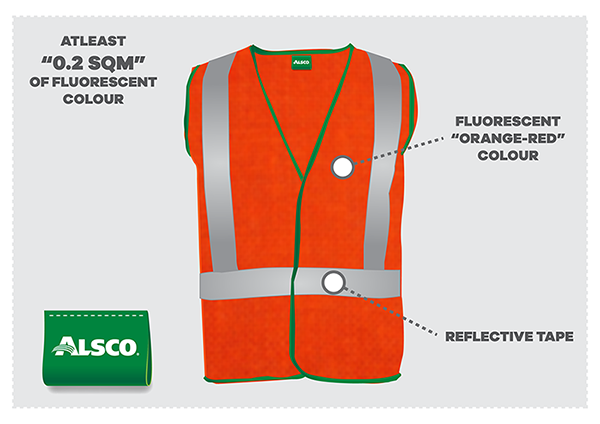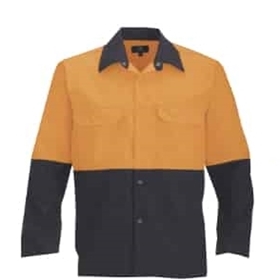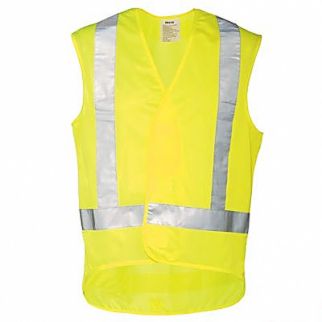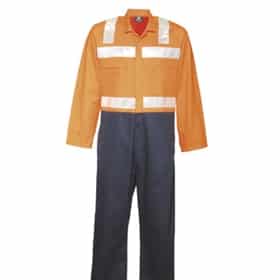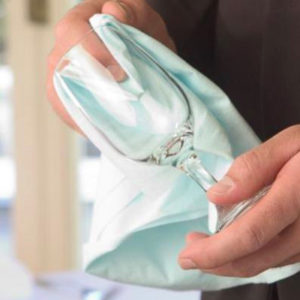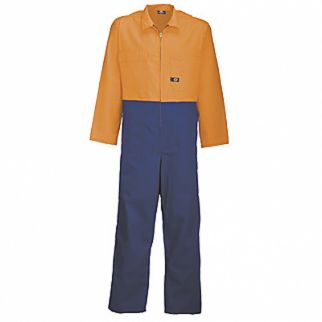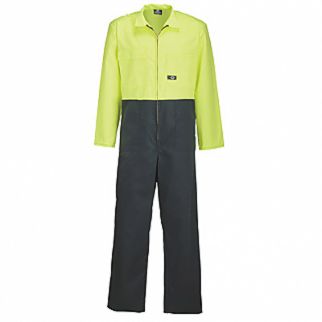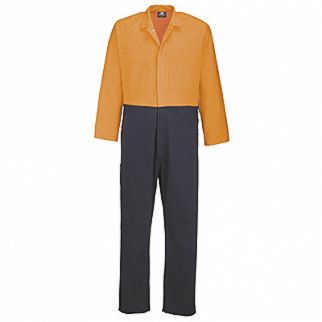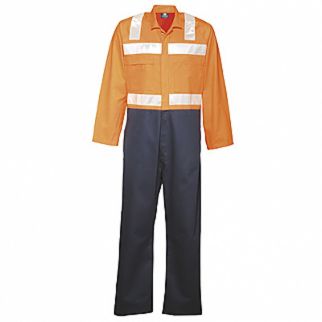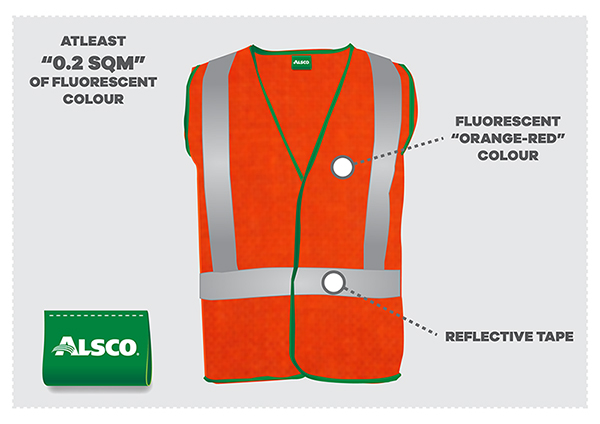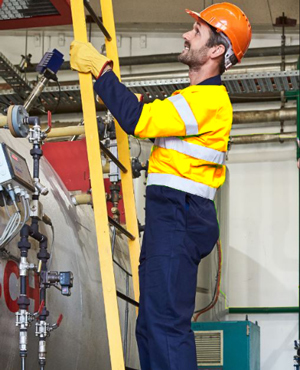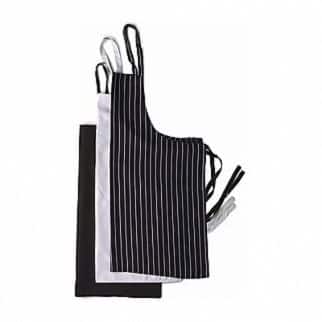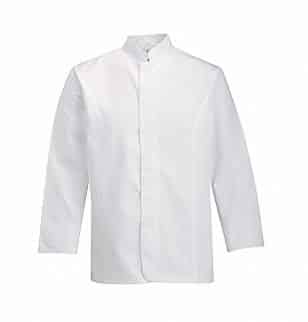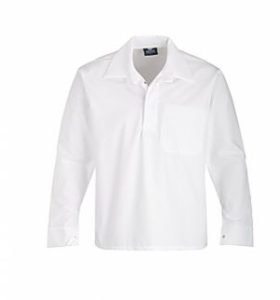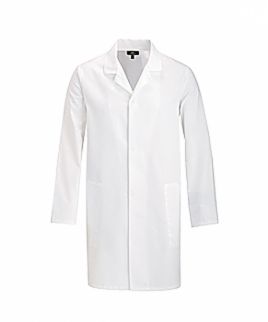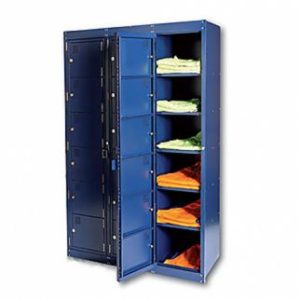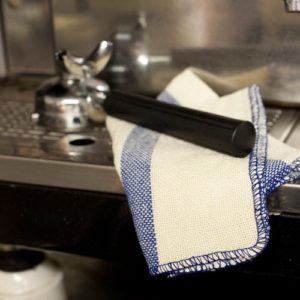How Does Hi-Visibility Clothing Work?
Hi-visibility workwear makes its wearers more visible. In that way, it is meant to prevent injuries and accidents.
People wearing a hi-vis vest, for example, are visible because the hi-visibility vest has patches of fabric that are either fluorescent or reflect the light.
Both of these types of hi-vis clothing work in a different way:
- Fluorescent hi-vis clothing is made out of synthetic materials to which a specific type of dye is added. This dye converts the short-wavelength energy into light. In that way, such hi-vis clothing is more visible.
- Fluorescent hi-vis clothing is most effective during daylight. Artificial lights, especially UV lights are not rich in short wave energy, so they reduce the effects of such clothing.
- Retroreflective high visibility clothing is best used for safety in traffic. It reflects the light that is pointed directly to it – like from behind the wheel. However, it is not that effective when observed from other angles.
The specifics of these high-protective uniforms are listed in AS/NZS 1906.4:2010 and AS/NZS 4602:1:2011.
The first standard deals with the fabrics, materials and colours that need to be used for Hi-vis clothing in NZ, while the second one deals with the possible applications of such clothing.
Instead of spending time and resources studying these standards and trying to apply them to your workplace, you can contact Alsco New Zealand and let them do that for you. Alsco NZ rents uniforms that match hi-vis clothing regulations in NZ.
What Colours Are Considered High Visibility?
The only two colours that are acceptable by hi-vis clothing regulations in NZ are yellow and red-orange.
Red is only allowed if it is in the orange spectrum. Otherwise, it cannot be considered a hi-vis colour, because it is not easily discernible for some people with a specific type of colour-blindness. This is regulated by AS/NZS 1906.4:2010.
However, hi-vis standards in NZ don’t stop at determining the colours. There are also some other, specific requirements. Some of them include:
- All hi-vis clothing in NZ is required to have at least 0.2 square metres of fluorescent material on the front of any hi-vis vest or another type of garment and the same size patch on the back. This fluorescent area should not be interrupted.
- The reflective hi-vis tape for clothing needs to be at least 5 cm wide. Hi-vis clothing regulations in NZ require for the tape to be in one of the five allowed positions.
- Logos can be used on reflective parts of clothing, as long as it still leaves enough reflective clothing visible. On the other hand, logos cannot be placed over the reflective tape and should be less than 10cm x 10 cm in size.
- It is permitted to add underarm venting squares that are up to 10cm x 10 cm of size.
- Reflective tape, logos, venting square and all other additions do not add up to the required size of fluorescent material.
How Many Classes of Hi-Vis Clothing Are There in NZ?
There are three classes of hi-vis clothing in NZ. They are Class D, Class D/N and Class N. Hi-visibility clothing regulations in NZ classify the garments in accordance with their use.
So, Class D is intended for daytime use, D/N for both day and night and N for nighttime.
Since these three classes have different uses, they also have to meet different hi-vis clothing regulations in NZ.
Class D – This type of hi vis clothing is intended for daytime use. It is not compliant with the hi-vis standards in NZ if it is used outside daylight hours. It needs to have at least 0.2 sq m of fluorescent yellow or orange-red colour on both front and back side. However, fluorescent colour should not be on the sleeves or collars.
Class D/N – For those that need to wear safety hi-vis clothing during both daytime and nighttime, Class D/N is the best option. It has similar requirements for the amount of fluorescent material on them, but there is also the requirement for strips of reflective tape. While fluorescent material is not suitable for nighttime, reflective tape is.
Class N – This type of hi-vis clothing is suitable for nighttime. Since the fluorescent colours are not visible without daylight, the colours of this clothing is not that important as long as it has enough reflecting tape on it. That tape has to be at least 5 cm wide and it has to meet certain configuration.
Who Invented Hi-Vis Clothing?
An American Bob Switzer is the person who invented hi-vis clothing. However, that was not his first intention. Namely, Switzer wanted to be a doctor. At the time, he was a manual worker in Heinz Ketchup factory in California.
One day, during work, sustained injuries to his head as a result of falling and hitting his head. Those injuries were so severe he ended up in a coma. As a result of this comatose state, his vision was in jeopardy of being permanently damaged. Doctors advised for him to remain in dark.
Since the recovery was long, Bob Switzer’s brother Joe wanted to help him by keeping him entertained, performing magic tricks. Joe Switzer found a way to utilise fluorescent chemicals to make his magic tricks more appealing for his recovering brother.
Bob Switzer enjoyed those tricks so much he continued experimenting after his recovery and ended up developing the ‘Day-Glo’ paint. Bob even used it to colour his wife’s wedding dress, making it the first hi-vis clothing in the world.
Later on, the safety and commercial applications of this colour became apparent and today, the safety hi-visibility clothing is used all over the world and in a wide range of industries.
If your business is one of those industries, it is important that you keep your employees safe by offering them safety hi-vis clothing. This can include overalls for NZ workplaces, or even just a hi-vis vest for every employee who needs to be visible in their workplace. Just take care that every employee gets the workwear that fits them perfectly to ensure safety.
You don’t have to worry about meeting all the hi-vis clothing regulations of NZ authorities or how you’ll pay for all that safety hi vis clothing. You simply rent all the necessary hi-vis clothing for a flat annual fee.
Alsco New Zealand always offers hi vis garments that are up to hi-vis standards in NZ. Regular cleaning is included in your price. Call us to learn more.
15 Crucial Factors for Managing Your Restaurant Front-of-House
First impressions count, especially when it comes to the restaurant business. It’s important for your front-of-house to be inviting and spacious for your customers. The restaurant front of house is usually made up of the dining area, the bar area, the waiting area and the reception.
When planning your front-of-house, you should keep in mind the staff members who you want to handle the customers.
Depending on the size of your business, these can include a shift manager, a host (sometimes called a maître d′), the waiters (also called servers) and even bartenders.
There are many ways that you can make your restaurant front-of-house inviting for customers and a great space for your staff to work in.
The Staff are The Stars of The Show
The staff members who serve your customers need to be well-trained, patient and have great customer service skills. There are a number of roles you can fill to adequately handle the front-of-house.
The General or Shift Manager: The front-of-house team needs a competent leader who will ensure that everything is running smoothly. The general manager hires and fires staff, oversees shift rosters and meetings, and ensures that he or she handles customer or team member queries.
The Host: Aside from the general manager, another crucial team member is often the host or hostess. This is the person who receives guests at the reception or reservation desk. They are impeccably presented and welcoming to the guests. Aside from receiving guests, they handle the waiting guests and also seat those whose tables are ready.
The Servers or Waiters: The servers or waiters are a vital element of your restaurant front-of-house team. They are responsible for taking food and drink orders at the tables, serving the guests and also making menu suggestions. They must have customer service skills to handle different types of customers, and their patience will sometimes be tested.
The Bartenders: If your restaurant front-of-house has a bar, then a qualified bartender or two can be a great addition to the team. Good bartenders create cocktails and any other beverages available at the bar. In some restaurants, the bar also serves as the waiting zone, so it’s often up to the bartenders to interact with the waiting customers.
The Restaurant Runners: In larger restaurants, the waiters usually get help from restaurant runners (or food runners). They keep drinks full, bring out the meals to the guests, clear the tables once the customers are done and even set up tables for the next group of guests.
How Do You Successfully Manage Your Restaurant Front-of-House?Ensure the Front-of-House Design is Practical
Alsco Restaurant/Hospitality Linens
When planning for your restaurant, it’s important to design the front-of-house to suit your guests and staff members. It’s all about the details. Just as the spaces between dining tables need to be compliant with the regulatory codes, the table linen needs to be clean and appealing to the eye.
The walkways need to allow for ease of movement and the lighting should be just right – not too bright, but bright enough for guests to read the menus.
While planning the front-of-house design, make adequate plans for your reservation desk, the bar, waiting area and payment station.
All these areas need to be well spaced as well as easily accessible to guests and staff.
Run a Tight Ship
Hold Pre and Post Shift Meetings: The staff are the stars of your restaurant show. They need to have a conducive working environment and should be well-trained. Run a session between key meal times in the restaurant where the team, led by the general manager or shift manager, divide roles among themselves while sharing any concerns they may have while on duty.
Alsco Wrap Waist Apron
Keep Staff Looking Good in Uniform: Your staff need to look professional to create a great impression with customers. The easiest way to keep your staff uniforms looking crisp and clean is by using a Managed Uniform Rental Service.
They pick up all your dirty laundry and deliver clean uniforms for your staff.
For an obligation-free quote or more information about their uniform rental service, contact Alsco today.
Provide Regular Training for Staff: To have a competent front-of-house team, you should invest in regular training for the staff. The most crucial training they need is customer service. Training should be continuous to ensure that new team members are also aware of best customer relations practices.
Monitor Team Activities: To run a successful restaurant, managers should be able to keep track of their staff members. One way to do this is to have an hourly staff labour report. You will be able to keep track of staff hours on duty as well as each task they have undertaken.
Motivate Your Team: From time to time, staff should be motivated and appreciated at the restaurant. A great example of staff motivation is to have a cocktail and menu tasting session for them to experience the restaurant menu in a relaxed setting.
You can also give them adequate time off and breaks so they are not overworked. You should also have an open communication policy at the restaurant. This will allow the management and the rest of the team to share any issues they may have outside of the shift meetings. A happy team will make your restaurant successful.
Use the Right Tools for Smooth Front-of-House Operation
Some issues customers can face at a restaurant include reservations and payment. As a restaurant owner, be on the lookout for the right tools that will ensure that all processes are running smoothly at your restaurant.
Reservation Tools: When it comes to reservations, make sure that all booking channels are monitored. Some restaurants receive phone reservations, the restaurant website or even an app (if available). The host and restaurant manager should work together to ensure all reservations are properly recorded.
When setting reservations, be honest with your customers. If the restaurant is closed for some reason or if reservations are full, be transparent and your customers will appreciate your honesty even if they feel disappointed.
 Image from: Freepik
Image from: Freepik
Payment Tools: Find out which payment methods most of your customers use and give your customers what they want. For example, you can use multiple payment stations or opt for a pay-at-the-table technology.
An integrated Point of Sale System allows you to track payments, sales, staff performance and overall restaurant performance. When looking for a POS System, request a demo session to see it in action and find out which features the best suit your business.
Data and Statistics Tools: Make use of data and statistics to determine what is working for your restaurant. The integrated POS system will help you determine which hours are busiest at the restaurant.
You can also keep track of which menu items are less popular based on orders. In addition, you can monitor staff performance to make any required team changes.
Photo: StockSnap
All You Need To Know About Hi Viz Clothing
Hi-Viz clothing stands for high-visibility clothing. This type of clothing, usually workplace uniforms, is any type of clothing that is reflective and easily visible.
It is used in many industries to boost the safety of the employees and prevent all the accidents that could happen due to people not seeing each other in time. It is present in many industries.
Hi vis clothing is used for those who work in the traffic and/or need to spend time working on the roads. Another industry that is known for their hi-viz clothing is the construction industry.
People there need to wear hi-viz clothing so that they prevent accidents.
Additionally, all workers that are employed in different types of warehouses, shipyards, airports and similar industries where the heavy machinery is used and a lot of items are stored need to wear hi-viz clothing.
Hi-viz clothing regulations in NZ that dictate the standards which have to be met by the workplace hi vis clothing are AS/NZS 1906.4:2010 and AS/NZS 4602:1:2011. These standards include the colours allowed for hi-viz clothing as well as some of the requirements that deal with the amounts of hi vis fabrics and similar details.
Why Is Hi Viz Orange?
The most of the hi-viz clothing for outside workers is orange because this colour stands out from the green grass and natural surroundings the most. Hi viz standards in NZ regulate the colour of the hi-viz clothing. They propose yellow and red-orange only.
Entirely red clothing is not allowed because people with some types of colour blindness have issues discerning it from the surroundings. For safety hi-viz clothing to be useful, it also needs to meet some other requirements.
- Hi-viz clothing needs to have fluorescent material on both the front and back of the garment.
- The minimum of fluorescent fabric on hi vis clothing needs to be 0.2 sqm on the front and the same amount on the back.
- This amount of fabric does not include the patches covered by logos, reflective tape and other items.
- The reflective tape needs to be at least 50 mm wide.
Since it is quite difficult to create hi-viz clothing that is made out of natural materials, it is allowed to create underarm venting patches. They make the clothing more breathable and allow for more comfort, especially in the warm weather.
How Does Hi-Viz Clothing Work?
Hi-vis clothing ensures increased visibility of its wearers. This is achieved by including fluorescent or reflective pieces of fabric into the uniforms. These two types of fabric achieve increased visibility in two different ways.
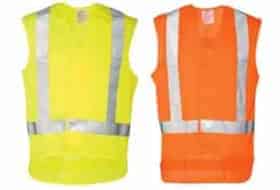
Reflective hi-viz clothing reflects the light that falls directly to it, under the right angle. If it is observed from angles that are not from the same direction as the light, the reflective tape is not that effective. It is usually used for the safety hi-viz clothing in traffic. This type of hi visibility uniforms is also used for nighttime. This type of hi visibility is usually achieved by hi viz tape for clothing.
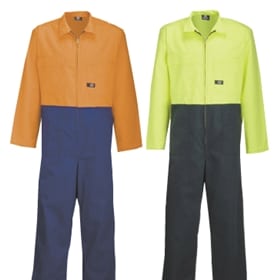
Fluorescent hi-viz clothing effect is achieved by colouring fabrics and materials with special types of dyes. This type of clothing is not suitable for nighttime use because it needs light to be visible enough. Namely, this type of dye uses short wavelength energy to convert it into glowing reflection. UV lights don’t have this type of energy, so this kind of hi-viz clothing is not usable under that sort of conditions.
How Many Classes of Hi Visibility Clothing Are There?
High viz clothing in NZ is classified into three classes depending on their appropriate use. There are Class D, D/N, and N.
Class N includes the type of hi-viz clothing that is used during the night. We already mentioned that the fluorescent dyes are not suitable for night use, so the visibility of these garments is achieved by hi visibility tape for clothing.
Class D is, obviously suitable for daytime use. Its visibility is achieved with fluorescent areas on the garments. Again, we already said that this makes them unusable during the night, but also under artificial lights, especially UV lights.
When these two types of classes are combined, you get Class D/N, which is hi vis clothing suitable for both night and day. This is achieved by combining the fluorescent patches and reflective tape.
How Often Should You Replace Your Hi Visibility Clothing?
It is best if you are able to replace your hi-viz clothing every six months. This goes for that hi viz garments that you use regularly. However, this lifespan of your high visibility uniforms can be seriously reduced if you are wearing it every day and under some conditions that can damage it.
Some of the things that can make your hi-viz clothing last shorter are:
- Extreme temperatures
- Bleach
- Extreme rubbing or wear
Therefore, extreme conditions and excessive wear can damage your hi-viz clothing. That is why it is important to inspect your garments after and before every use. That is how you will know if it is ready to be replaced.
You will know that it is time to replace your hi visibility clothing if you find that it has faded, is torn, dirty beyond the possibility of washing and not visible from afar.
There is another option when it comes to ensuring visible and sanitary hi visibility clothing. You can simply rent it from Alsco New Zealand. Alsco NZ has hi visibility clothing for NZ businesses which matches all the hi viz standards in NZ.
Moreover, we will deal with the cleaning, replacement, and maintenance of your rented hi vis clothing. It is all included in your price.
Whichever option you choose – buying or renting hi-viz clothing – it’s absolutely critical that you learn how to size your workwear properly.
Call Alsco NZ today, and we will explain this in more detail, but here is how our rental process works:
- You call Alsco NZ and tell us how much hi viz clothing you need.
- We agree on the frequency of laundering the hi viz clothing you ordered.
- We deliver the uniforms as agreed.
- After the usage, you dispose of the hi viz clothing so we can pick it up.
- We pick up the dirty garments and leave the clean ones for you to use.
The best part? All this is included into a flat annual fee that you can agree upon with our representatives right now. Call Alsco NZ and get your quote.
Photo courtesy of Freepick by Free Stock Center
What Is a Hi-Vis Vest?
A hi-vis vest is a piece of hi-visibility clothing. It means that it is a vest that is highly reflective and is easily seen against most backgrounds. Obviously, its purpose is to make its wearer more visible and prevent injuries and accidents.
(Note: The prerequisite for reliable injury prevention is measuring your workwear properly.)
Hi-vis vest uses a combination of fluorescent fabric and reflective tape to achieve the highest levels of visibility during both day and night.
Hi-vis clothing regulations in NZ require that the hi-vis vests are a yellow or orange colour. These colours need to be fluorescent. The hi-vis standard in NZ which deals with the fluorescent colours is NZ AS/NZS 1906.4:2010.
There is another hi-vis standard in NZ that deals with the high visibility clothing and their design features. That is AS/NZS 4602.1:2011. Here are some of the rules about hi-vis vest design:
- There has to be at least 0.2 sqm of uninterrupted yellow or orange fluorescent colour on the front of a hi vis vest and the same amount on the back.
- Reflective tape needs to be 5 cm wide and it should be positioned in one out of five permitted configurations.
- Any logos, signs and other elements on the hi vis vest should be excluded when calculating the total of interrupted fluorescent fabric. This includes the reflective tape.
Alsco New Zealand rents hi vis vests that meet all the standards, regulations and criteria of New Zealand authorities. We rent hi vis vests to many companies from different industries.
Regardless of how different these companies are, they use the high visibility vests for the same thing – safety of their employees. Let’s look into how the hi visibility vests are used.
What Is High Visibility Vest Used For?
Generally, a hi vis vest is used for any situation in which a person needs to stand out from the background and be visible to others in those surroundings. The most common example of hi visibility vest in use are the uniforms of railway and highway workers. Others occupations that also use hi-vis vests are:
- Airport employees
- Construction workers
- Utility workers
- Tow-truck drivers
- Heavy equipment operators
- Toll booth operators
- Parking attendants
- Firemen
- Policemen
- Event security
Many other occupations also may have the need for the hi vis vest use. Moreover, hi vis clothing is used by hunters and cyclists, as well.
Hi visibility is important for all these occupations. However, not all of these occupations benefit from increased visibility in the same way. Namely, hi vis clothing offers three benefits to its wearers:
- Increased safety – this is the most common and the most obvious benefit of hi vis clothing. Employees who wear hi vis apparel are more visible and less likely to be involved in accidents. This function is especially important for highway construction workers, parking attendants and all those who spend a lot of time in traffic.
- Easy identification – occupations such as firemen, emergency responders, policemen and security workers need to be easy to spot by the others. People in emergency situations need to be able to identify the closest policeman or a security officer as soon as possible.
- Brand boosting – if the hi vis vests that a company uses are large enough, there is enough place for the company logo on the back. As long as it doesn’t interfere with the reflective tape and the coverage of the fluorescent fabric is still at least 0.2 sqm, it is possible to add logo.
Now you know what are hi vis vests used for and how they benefit the companies and different industries. The question remains – how does that even work?
Hi vis vests work on the same principle as the rest of the hi vis clothing. So, let’s examine what that really means.
How Does Hi Visibility Clothing Work?
Hi vis clothing works on the principles of conspicuity. This means that a hi vis vest attracts the attention of other people in the surroundings, even if those people are not actively trying to spot the wearer of the hi vis vest.
How? This is where the answer gets a bit more complicated.
Conspicuity is achieved through visibility and recognition. In other words, for hi vis clothing to work, it should be easily spotted and easily recognised as a type of “warning”. Let’s start with visibility.
Visibility of hi vis clothing is achieved with the choice of colours and with the addition of fluorescent and reflective fabrics. Colours that ensure increased visibility are yellow and orange. To make sure that these colours are even more prominent, it is best to use them next to black, dark green or navy for contrast.
Orange/Royal Blue
Yellow/Green
This contrast will make the colours stand out during daytime. However, for the nighttime, the fluorescent hi vis clothing needs to be complemented with the reflective tape.
Recognition of hi vis clothing means that certain colours of hi vis clothing make us more attentive. In simple words – if you see the highly-recognisable bright yellow colour on the road, you will immediately be aware that you should be careful and pay attention to the person who is wearing such hi vis vest.
On the other hand, the orange-red hi vis colour, or “safety orange” is recognised by many as a sign for caution. This is also the colour of many signs, traffic cones and other traffic elements. Most of people will subconsciously react to it and recognise it.
People easily spot hi vis vests and they associate their wearers with safety workers, emergency responders and similar occupations. Consequently, they drive more slowly, become more aware of the heavy machinery dangers and become more careful, in general.
However, for hi vis vests to do their “magic” and to have all the above listed effects, they need to be clean and regularly maintained.
How Often Should You Replace Your Hi Visibility Clothing?
In general, you should replace your hi vis vest every six months. However, if it is rarely used, you should replace it once it is not visible from 300 m. If it is used sparsely and maintained regularly, it can last up to three years.
Hi vis clothing is made out of fluorescent material and reflective tape. For these two elements to remain functional, you need to clean them regularly. Any dirt or soil on them will block the light from reaching it and that will render them useless.
Fluorescent material actually converts the light of certain wavelength into that recognisable glow. It is impossible to happen if the dirt blocks the light from reaching it.
Similarly, the reflective tape works on the principle of micro-prisms or glass beads. They reflect the light directly back to its source. Dirt and soil will be on the way of the light and that means that the reflective tape won’t be able to reflect it.
Cleaning and maintaining your hi vis clothing is not difficult. You should clean it with a mild detergent in cold water and dry it without excessive heat. If you opt for machine washing, you should choose a program that washes your hi vis vest in cold water.
There is also an easier way to keep your hi-vis clothing up to date – you can rent it from Alsco New Zealand. In that way, you don’t have to worry whether your hi vis vest is already six months old or not or whether it is still visible enough.
As soon as your hi vis clothing is dirty, you just need to put it in a hamper and you will be delivered fully visible and spotlessly clean replacement first thing in the morning. That is what you get for choosing to rent the hi vis clothing.
We will come and pick up your dirty laundry and leave you with fresh and clean uniforms at the same time. All this is included in your affordable annual fee. Call Alsco New Zealand today and learn what is your best quote for this amazing service.
6 Ways Protective Workwear Benefits Your Organization
Let’s be honest. You wouldn’t think of going fishing without bringing along the right tackle. Would you?
Then why allow your workers to work without protective workwear? Protective workwear keeps workers safe from injuries.
But if the protective workwear is for the benefit of the worker, why not ask them to buy their own? This is a dilemma that many organizations face.
If you are in a similar situation, read on.
Protective workwear is, to a large extent, personal. Yet, providing it for your staff speaks volumes.
It shows the organization’s attitude and commitment to the safety of its staff.
Your workers do a tough job. At the very least they deserve protective workwear.
Whereas this benefits the worker, it also benefits the organization. Here are six benefits, although there are many more:
- Promotes an organization’s brand.
- Encourages uniformity and professionalism at work.
- Helps an organization follow the set regulations.
- Makes the workplace safe and secure to work in.
- Saves the organization money.
- Fosters team spirit in an organization.
Let’s have a look at each benefit.
1. Promotes an Organization’s Brand
Your staff’s workwear forms a key part of your company’s identity. It is a great marketing opportunity for your organization.
If used well, you can establish a strong brand identity. Which helps in making your brand recognizable to the public, and more likely to generate repeat customers.
To maximize this, customize the workwear. Include your organization’s logo and corporate colors on it. This helps to make it distinct from other companies.
Every time your workers wear their branded workwear, it markets your organization. Those who don’t know it gain awareness. And as for your regular clients, the branding enables them to spot your company from a distance.
You can brand your workwear in either of these two styles:
- Printing. This is a fast and cost-effective method. You can print the company logo on any material, including high-visibility jackets.
- Embroidery. This involves stitching the logo on the fabric. Making it ideal for non-waterproof workwear. Embroidery is longer-lasting than printing even after several industrial washings of workwear. Also, the process takes a longer time than printing. Embroidery is advisable when branding workwear using small logos.
2. Encourages Uniformity and Professionalism
It is difficult for workers to flout rules when they are wearing branded workwear. Your organization can use this to its advantage.
When your staff is in matching uniforms they become the spokespeople for your company. A branded uniform helps staff embody the company and keep them in character throughout their shift.
Customers are more relaxed approaching staff in uniform. When staff is in uniform customers feel more comfortable approaching them with questions, concerns, or advice. The uniform represents the brand and signifies to the customer that the employee is there to help.
Branded workwear presents a professional image of your organization. Clients can identify your staff and the company they associate with. This improves client service.
This can also lead to more business. When people see your staff looking professional, they may want to work with you or seek your organization’s services.
It creates uniformity and equality. Everyone looks the same and feels comfortable at work.
3. Helps Organization Follow Regulations
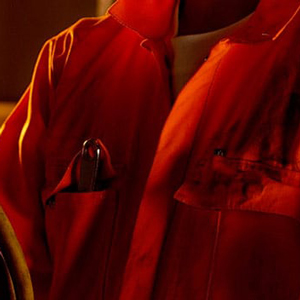
There are laws that demand organizations to safeguard the safety of their workers. Failure to adhere to the law results in consequences.
For example, New Zealand has a Health and Safety at Work Act 2015 (HSWA). The act states that a person conducting a business or undertaking must ensure, so far as is practicable, the health and safety of workers. Also, that others are not placed at risk by the execution of the work.
This is a primary duty of care of an organization to its staff. You don’t want your organization to neglect this duty. You risk a legal suit when on the wrong side of the law.
There are different levels of protection depending on the level of risk. But how does an organization know what workwear to provide staff with to keep them safe?
For example, there are different classifications of hi-vis workwear. Each depends on the level of risk exposed to:
- Class 1. This is the lowest and most basic level of protection. Wear protective workwear in work environments of minimal risks. For example, wearing only a hi-vis shirt or trousers, but not both.
- Class 2. This is an intermediate level of protection. The protective workwear is more visible in the dark with shining headlights. For example, wearing a safety vest.
- Class 3. This is the highest level of protection. It is for environments that have a high level of risk. For example, wearing a hi-vis overall.
4. Make the Workplace Safe and Secure
Protective workwear makes employees feel safe and comfortable at work. It shows that the organization cares about the wellbeing of its staff.
Many industrial workplaces can be dangerous. Especially for employees who are not wearing proper protective equipment.
By ensuring that your employees have access to appropriate, high-quality, and industry-specific workwear as well as a trusted laundering service, you make the statement that you genuinely care about the health and well-being of your staff.
This positions the organization as the ideal work environment for prospective and current workers. The organization doesn’t have to worry about losing its skilled workforce.
When workers feel safe and secure, they are more engaged at work. They also stay longer with organizations. This reduces time off work because of illness or injury. The Queen’s School of Business and the Gallup Organization back this research.
The studies showed that disengaged workers had a 37% higher rate of absenteeism. Also, 49% of these workers had more accidents, and 60% had more errors and defects.
With protective workwear, it is also easy to identify those breaking the rules. Refusal to wear protective wear can be catastrophic for the individual and company. You can face legal action in case of an accident.
5. Save the Organization Money
Claims from accidents at work are costly! As an organization, you lose money, trained human resources and working days.
In fact, the cost can be so much that it drives you out of business. That is why organizations need to have safety measures in place to protect them in case of an accident.
Many organizations shy away from the cost of purchasing protective workwear for staff. This is a huge cost, especially where you have hundreds of staff.
While it might be an initial expense, you can save on lowered insurance premiums. This will help you recoup the costs associated with purchasing the protective workwear.
Besides buying protective workwear, put in place training programs to prevent injury and illness. This helps in risk reduction.
Sometimes, your insurance provider may lower your premium. This happens if there is a lower safety risk based on the measures your organization has taken.
Studies show organizations that invest in safety at work save money through:
- Reduction of insurance premiums for workers’ compensation.
- Fewer resources spent on the paperwork of filing injury and illness reports.
- Less money spent on compensating workers.
- Fewer resources spent to train new staff. Also to replace those absent from work due to injuries, illness or death from work injuries.
6. Foster Teamspirit.
Let’s take sports for example.
Notice how fans of a sports team wear their branded gear with pride?
It makes them feel part of the team. They are happy and proud to associate with that team.
They spend money purchasing branded items of their team so they can feel a sense of belonging.
That is how you want your staff to feel when they wear branded protective workwear. To ensure this, buy protective workwear that plays a functional and an aesthetic role.
You want your staff to not only be protected but also look good in their workwear. Let the protective workwear be well-fitting.
Factor in different styles and body shapes of your staff. Also, be gender-sensitive. This may seem expensive but remember it is a worthy investment.
It promotes unity and a sense of belonging among staff. Staff are proud to associate with your organization. They look out for each other and for the interest of the company.
This can turn your staff into brand ambassadors. When the staff is happy at work, their performance improves. There is also an increase in productivity.
Final Thoughts
Now you believe that protective workwear can benefit your organization.
Wondering where to buy protective workwear in New Zealand? And who will provide the most reliable options?
A trusted brand can help your business keep staff safe. Some huge benefits of purchasing protective workwear from a reputable provide include:
- High-performance protective wear. That is durable, safe and heavy-duty.
- The best price guarantee. Customers who buy in bulk get huge discounts.
- Branding your protective workwear. This improves a company’s image.
- Workwear sourced from the highest-quality manufacturers in New Zealand.
Getting in touch with friendly customer service representatives and finding a quote will help you place the perfect order for your organization.
Article contribution by Alsco New Zealand. Alsco aims to help create a healthier and safer workplace by providing affordable yet high-quality uniform rental service and hospital-grade first aid solutions.
Photo: Kevin Phillips
Get the Most Wear and Performance from your Workwear: 4 Top Tips
Staff are the most important asset in an organisation. The beginning of the year is as good a time as any to kick work safety into high gear.
As a manager, you know the importance of protective workwear.
- It ensures the organisation complies with the legal requirements
- It keeps your staff safe
- It increases work productivity
- It gives staff professionality
- It is a great opportunity to brand your organisation
You have convinced your organisation to buy workwear for its staff. This is a huge investment and it is up to you to ensure you get the most from it.
It is natural to use pricing to judge the value of the workwear. Managers are often under immense pressure. They want to improve work safety but within the budget of the organisation.
But it takes more than price to get the most wear and performance from your workwear.
So what exactly does it take?
The answer to this question, and more, lies within the sections below. Let’s dive in!
1. Buy Workwear for Longevity
Quality is a MUST when considering buying workwear. Select workwear made of high-quality fabric so it serves you for a long time.
Cheap may be very expensive in the long run. The workwear deteriorates fast and is not up to the job. It ends up serving you for only a short period and exposes your staff to risk.
Before long you are back at it again – convincing the organisation to buy new workwear for staff.
You may be wary of the higher initial cost of buying high-quality workwear but think of it as an investment.
You could cut down on the cost. Companies such as Alsco give you a discount if you buy in bulk and they also provide transport. This will save the organisation a few coins.
Don’t compromise by buying cheap workwear made of low-quality fabric. Your workwear is an important part of branding. It reflects the organisation’s image to the public.
Your staff serve as brand ambassadors of the organisation. If they wear high-quality workwear, it gives your organisation a good image. And the vice versa is true.
For your workwear to last longer, it also needs to be functional. It shouldn’t hinder the worker’s productivity.
For example, don’t buy workwear in bulk without factoring in the different sizes of your workers.
If it is too tight, loose or heavy, it won’t serve your company well. Loose or tight clothing is prone to catching and tearing on corners or wearing through quickly as seams are under increased strain. Customise it so it is light, well-fitting and gender-sensitive.
A smart way to go about this is to first make one order of the workwear. Test it to ensure that it is a good fit for your staff and organisation.
Only when you are sure it fits well should you order in bulk.
2. Use the Right Workwear for the Right Job
Every industry demands specific requirements of the workwear. It is important to factor these before buying.
Start by first listing down all the job-related features you need from your workwear. Once you are clear about this, make an order. Emphasise that the workwear needs to have these features.
It should also follow all the applicable safety regulations. For example, in New Zealand, the Hi-Vis AS/NZ 4602 regulates all hi-vis workwear.
There are three classes of workwear depending on the type of risk. Choose the right high-visibility for the job.
- Performance Class 1. This is for low risks. Usually, this workwear has the least amount of reflective material. Workers use it in a non-complex work environment. For example, a hi-vis shirt.
- Performance Class 2. This is for medium risks. It includes workwear that has more hi-vis material and designs. This workwear makes the employee stand out in a more complex environment. For example, a sleeveless safety vest.
- Performance Class 3. This is for high risks. It has similar requirements as class 2, but with more hi-vis reflective material. This covers the arms and legs. For example, a hi-vis overall.
3. Follow Wash Care Instructions
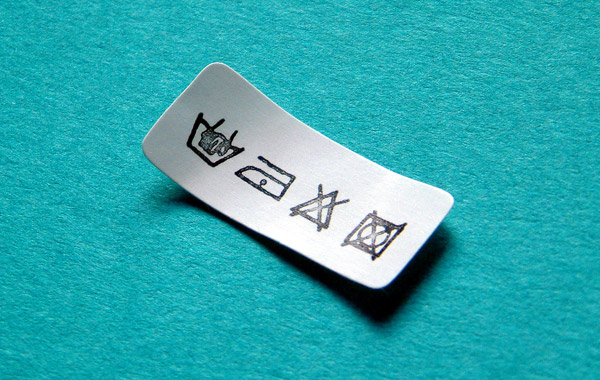
Photo by Marcel Hol from FreeImages
Your workwear should uphold the highest standards of cleanliness. Failure to do so compromises on the level of protection it can offer.
For example, when high-visibility clothing is not well cleaned and maintained the dirt on the retro-reflective material can lower visibility.
Washing workwear in the wrong way will damage the item. You want to take care of your workwear so it will serve you for a long time.
All workwear has wash care instructions provided on the labels. The manufacturer places them there for a reason.
Failure to follow the wash care instructions can cause the fabric to shrink or loosen when you wash.
Encourage your staff NOT to wash workwear by hand. Instead, use a washing machine.
Wash workwear only as needed. Don’t keep them dirty for too long. The dirt will stick and become difficult to clean.
Beware that only cleaning workwear every now and then will cause wear and tear. If possible, provide your staff with another set of workwear so they can alternate.
Separate them from other clothes and wash workwear alones. Mixing them with other clothes can cause cross-contamination of germs.
Your personal clothes can also colour bleed on the reflective material. This will reduce visibility of the workwear and put a worker at risk.
Use a normal mild detergent when washing. Avoid softeners and harsh chemicals such as chlorine bleach and oxygen peroxide. These will end up damaging not only your workwear but also the environment.
Once cleaned, tumble-dry your workwear. Avoid drying them under direct sunlight as they risk fading. Also, some fabrics shrink when dried under direct sun.
4. Always Check Workwear for Damage
Take stock of all the workwear that need repair and those that have been lost. Plan to replace those lost and repair the torn ones as soon as possible. Remember, a stitch in time saves nine. Replace those lost immediately.
Encourage your staff to take some personal responsibility for their workwear. It is only right for them to report when the workwear gets lost, needs repair or replaced.
Sometimes, you have no other option than to replace the workwear with a new one. Such situations include:
- If the workwear has exceeded its shelf life.
- If staff have lost their workwear.
- If the tear on the workwear is beyond repair.
- If some staff have soiled their workwear and cleaning no longer restores it.
It is difficult to track all of this on your own. Why not consider commercial services for cleaning your staff’s workwear?
Alsco New Zealand are experts at these services. They have been in business for 125 years.
They guarantee :
- Convenience. Alsco not only sell you the right workwear but also provide you with a workwear rental service. You only deal with one supplier for all your workwear needs.
- Affordability. You get the best price every time. For example, with one annual fee, you get an array of services. They change soiled workwear for fresh, spotless and sanitised ones. It doesn’t matter how demanding your business is, they cater to you.
- Safety. Alsco makes workwear with high-quality fabric. It is also 100 per cent compliant with safety regulations. Giving you peace of mind.
- Customised services. Alsco tailors their services to your needs at no extra cost. With 125 years in business, they have perfected the art.
Save your time and money. Get in touch with Alsco and make your order today. They will help you find the perfect workwear that can serve you for a long time.
Photo: Pressfoto
4 Untapped Ways to Truly Delight Your Restaurant Guests in 2020
How can customer experience be improved? How do I keep my restaurant guests happy?
If you’ve found yourself asking questions along these lines, you’re in the right place.
It’s that time of year again. We’re setting personal resolutions (and crossing our fingers that we’ll stick to them).
Now is also an opportune time to draw up plans that will advance your business. The basis for delighting your restaurant guests in 2020 is simple but powerful:
Think like your guests. Strive to offer them what they want and need.
You can do just that in the four ways outlined below.
1. Maintain Cleanliness and Orderliness by Doing This
When running a restaurant, the workload can run you down. There are times it feels like you’re juggling too many tasks all at once.
How, then, do you keep everything in check?
Get a little help. Why not outsource some of the work?
Stop worrying about cleaning and maintaining all your employees’ uniforms. Instead, work with a managed uniform rental service.
Why? This is beneficial to your establishment in numerous ways.
First and foremost, you get to have all your workwear needs met, from aprons, chef jackets and trousers, to jerkins and waiters jackets.
[b3_row]
[b3_column lg=”4″ md=”12″ sm=”12″ xs=”12″ ]
[/b3_column]
[b3_column lg=”4″ md=”12″ sm=”12″ xs=”12″ ]
[/b3_column]
[b3_column lg=”4″ md=”12″ sm=”12″ xs=”12″ ]
[/b3_column]
[/b3_row]
Furthermore, a managed uniform rental service can save you time, energy and money by:
- Keeping track of every single uniform so you don’t have to.
- Having workwear repaired and replaced.
- Keeping uniforms clean and presentable.
Plus, renting uniforms is more cost-effective in the long run.
It’s better than buying a new one every time someone joins your staff or there’s a lost or damaged garment.
With more time on your hands, you’ll be able to keep your establishment in order.
Maintaining a clean and orderly restaurant not only results in a hygienic environment. It also plays a crucial role in the perception of your restaurant.
Go over all the little details. They can greatly affect the impression upon your customers.
2. Offer the Two Things More Important than Good Food
Restaurants aren’t just about the food.
If that’s the case, then what more do your guests want?
First, they want a fulfilling dining experience.
Put yourself in your customer’s shoes. Think of all you can do to keep them satisfied while at your restaurant.
People appreciate experiences that aren’t riddled with hiccups. Find every possible hitch and brainstorm on how to rectify them all.
From the moment a customer walks in, to the moment they leave, make sure they have a good time.
It’s also important to stay consistent. If your diners have a good time today, then, by all means, they should enjoy themselves every other time they stop by.
Be a great host at all times. Have guests welcomed cordially and directed to a table as soon as they arrive. Keep in mind that delays are a pet peeve for many diners.
They don’t want to wait too long to:
- Receive the menu.
- Have their order taken.
- Get served.
- Receive their bill.
And yet, despite your best efforts, delays are inevitable.
In such instances, your customers will appreciate being honestly informed about waiting times.
This applies both to finding a table as well as when they can expect dishes that take longer to prepare.
And while they wait, help them while away their time.
There are two easy and effective ways to do this which will keep patrons busy.
- The first is to provide free Wi-Fi. Don’t let the financial implications of making such a move discourage you.
Customers can spend up to 50% more in establishments that offer them connectivity. - The other is to offer free appetizers. While guests await their meal, give them a complimentary light snack or breadbasket.
The second thing diners want is exceptional customer service.
Excellent culinary delights can fail to impress if accompanied by unsavoury customer service.
And Kiwis take service very seriously. 61% of people wouldn’t return to a restaurant with unsatisfactory service.
3. Keep Up With These Big Restaurant Trends in 2020
This isn’t to say you should just go with the flow.
Rather, keeping tabs on trends will help you better understand market dynamics.
Doing so can give insight into what new ideas are a match for your business, so you don’t get left behind.
Industry experts have already identified what will shape the restaurant landscape this year.
Here’s a rundown of what to expect.
Sustainable Sourcing
If there’s a pressing issue among many restaurant-goers today, it’s the “how” factor.
People are becoming more concerned about the sourcing of the food they consume.
This is set to continue over the year for two reasons:
- increasing consumer consciousness, and
- a greater interest in transparent processes.
How can your restaurant benefit from this? By showing commitment to ethical and humane practices.
Locavore Dining
A locavore is a person who prefers consuming food grown locally. This trend goes hand in hand with food sourcing.
People who identify as locavores prefer organic farm-grown food. Their lifestyle aims at supporting local farmers.
Food Waste Management
2020 will see a greater interest in how dining establishments handle food waste.
It’s only natural that if people have concerns about where their food comes from, they’ll want to know where its remains go.
It’s not hard to see why.
- Every year over 1 billion tonnes of food goes to waste.
- 70 per cent of food turns to waste even before it gets onto a customer’s plate.
- Of this, restaurants alone account for 40 per cent.
You can reduce food waste in several ways.
- Keep track. Develop an inventory to identify how much waste you generate and where it’s highest.
- Evaluate. Go over your purchases and compare this to consumption.
- Repurpose. Anticipated demand won’t always be accurate. Find ways to safely repurpose ingredients rather than throwing them away.
Other trends to keep an eye out for are:
- Reduced plastic usage
- More plant-based foods
- Foods harvested in a manner that encourages soil regeneration
- Healthier options for kids’ menus, such as whole-grain food
4. Harness the Power of Technology
If one thing is certain in New Zealand’s restaurant industry, it’s got to be competition.
While some are ceasing operations, many new restaurants are opening their doors.
For perspective, 7 new hospitality outlets open up every day across New Zealand. So, how can you give your establishment an edge?
Make technology work to your advantage. This will result in a more efficient and effective business environment.
Remember the point about having a seamless experience? Technology can make it a reality, and offer you several benefits.
More Data, Better Insight
Data analytics contribute to a better understanding of consumer behaviour. You can match your restaurant operations to your client demographics and psychographics.
Improved Internal Processes
From interactive, on-demand training to better communication among staff, the possibilities are endless.
Using cloud-based applications can improve workflow and make collaboration much easier.
Hassle-free Online Reservations
Offer convenience to your customers. Enabling them to book their table before they arrive makes their lives easier.
It will improve your planning while helping to reduce queues and commotion.
Next-Level Menus
The static paper menu of today may soon be a thing of the past with an interactive digital equivalent.
Picture a menu that suggests meal and wine pairings. Or displays options based on pre-selected dietary preferences.
Using a tablet and software, you can do this and blow your customers’ minds.
Online Orders
New Zealand has one of the highest rates of ordering food in rather than dining out.
While taking orders by phone is fine, a growing number of people prefer to order online.
If you don’t already fulfil online orders, you may be missing out on serving a quarter of the country’s population.
Remember, Customer Service Is Make-or-Break
At the end of the day, exceptional service is your greatest asset.
The warmth of a server’s smile, their professionalism and their presentability are an absolute delight.
Plus, they set the pace for a customer’s satisfaction.
Your customers will recall all this. In turn, it will inform their decision on whether or not to return.
Invest in training your staff and in keeping them looking their very best.
The easiest way to do the latter is to choose a managed uniform rental service that meets your unique needs.
Alsco’s trusted service offers you a comprehensive catering workwear solution.
By choosing Alsco, you benefit from:
- Workwear customised to match your brand identity
- Sanitary, durable uniforms
- An extensive range of styles and sizes
- A sophisticated barcode system to keep track of all uniforms
- Flexibility to meet your changing needs at no extra cost
- Trusted, reputable, service for one annual fee
All this starts from as little as $1 a day.
Get a quote tailored just for you.
Photo: Freepik
How to Choose the Best Pharmaceutical Workwear in New Zealand
Clothes maketh the man (or woman). Does pharmaceutical workwear matter?
According to Desmond Morris, author of Manwatching: A Field Guide to Human Behaviour, it is impossible to wear clothes without transmitting social signals.
What does this mean? Based on your outfit, people make judgements on credibility, likeability, education and trustworthiness.
In Morris’ study, some participants were shown photographs of a model dressed in different styles and were asked to appraise each one using adjectives.
Target subjects included students (judging what teachers wear) and patients (judging doctors’ attire).
The research found that the perception of professionalism and competency changed depending on what the model was wearing.
The last thing you need is for your clientele to view your staff as incompetent or unprofessional. This is why professional uniforms are essential for pharmaceutical workers in New Zealand.
Why Are Staff Uniforms Needed in the Pharmaceutical Industry?
Pharmaceutical Workwear Increases Credibility
Attire can affect the behaviour of others. For example, one study showed that people are more likely to respond to a request from someone in uniform than to a request from someone not in uniform.
It makes sense that the style of dress influences patient-pharmacist relationships. It also affects relationships with other healthcare professionals.
Pharmaceutical Workwear Increases Safety
In an environment where hygiene is paramount, the right attire protects staff from any potential harm. There are strict hygiene rules in the pharmaceutical sector, and the right uniforms help the staff to follow them safely.
When your staff are the first line of defence against bacteria, it pays to have them well-equipped. Minimal, smart and bacteria-resistant clothing is your best bet.
In some organisations, pharmacists choose what they wear as long as they are presentable. If they wish, they can wear the same uniform as technicians (tunic tops and trousers). Identification badges, therefore, become their main means of identification as pharmacists.
When pharmacists go into a room where a patient is in isolation, they wear an apron and gloves, while in infection outbreaks, they wear “theatre blues”.
Pharmaceutical Workwear Increases Trustworthiness
Consumers associate positive traits with uniformed employees. A uniform implies a higher work ethic and inspires a greater sense of trust and confidence.
When a consumer sees an employee in uniform, they feel like they will receive a better product and higher quality of service. With such positive results, it only makes sense to give your staff uniforms that help customers be identified as the hard-working individuals that they are.
The choice of colour also matters when picking uniforms for pharmaceutical staff. Would you trust a pharmacist in festive colours? A crisp white shirt or blouse adds an edge to casual dressing. Also, it adds customer trust in your staff’s professionalism. You need distinguishable professional garments to add points for believability.
How to Decide the Type of Uniforms Your Company Needs
Pharmaceutical journals and schools are debating the best attire for pharmaceutical practitioners. One size does not fit all. There are important considerations when selecting uniforms for your staff.
Assess Your Staff Work Demands
Do your staff members get in direct contact with customers? Consider uniforms that are simple enough to convey approachability. If your staff needs to go into a room where a patient is in isolation, provide aprons, gloves and identification badges.
If you decide to use the white coat as a uniform, ensure it is laundered. Daily cleaning is the best for infection control. In fact, the British Medical Association identified wearing white coats as a potential source of cross-contamination. This is due to their low frequency of getting washed.
The disappearance of white coats amongst the pharmaceutical fraternity is not just a matter of cleanliness. It signals a cultural shift that places the customer’s comfort as a priority.
Be Mindful of Design Needs
Since your staff members will spend all day in uniform, make sure it is easy to work in. Use high-quality poly-cotton blend fabric, best known to provide comfort, durability, and safety.
The cotton allows air to circulate, making the fabric breathable and perfect for hot workplaces. It is also odour-resistant and does not tear easily.
You need to protect staff from contamination or being sources of contamination.
Poly-cotton blend fabric is known to be long-lasting and strong. It is also wrinkle-free to keep your staff looking professional and neat throughout the day.
Consider Customer Expectations
To test the perception of a pharmacist’s competence based on attire, researchers did a study. They concluded that dress is not likely to influence a person’s evaluation of a pharmacist, especially when their performance is considered.
However, attire is an extrinsic cue likely to be used as a quality indicator when a consumer doesn’t have adequate information about intrinsic attributes. In other words, what a pharmacist wears may enhance the first impression.
On the flip side, a white coat may spell professionalism but intimidate patients. Staff on psychiatric or paediatric wards shun the white coat for this reason. It contributes to “white coat hypertension”, where blood pressure is elevated in clinical settings. This is due to the heightened anxiety of a customer during a consultation.
How to Find the Best Pharmaceutical Workwear Supplier
Pay Attention to the Fabric & Fit
If you wish to start a dress code, ensure it does not contravene the Employment Equality (Religion or Belief) Regulations. The Advisory, Conciliation and Arbitration Service (ACAS) advises that general dress codes that conflict with religious requirements may constitute indirect discrimination.
For example, aside from a wedding ring, Hindu women often wear a necklace (mangal sutra) placed around their neck during the wedding ceremony. Some may find it distressing if not allowed to wear it at work unless the rule was for justifiable reasons.
What pharmacists wear could influence how they behave, as well as their service delivery. If they are not happy with their uniform, they are not going to perform as well. It is good to pay attention to the thoughts of your staff before enforcing a certain dress code. If possible, involve them in choosing their uniform.
The future of uniforms is evolving to simpler cuts and styles. Scrub suit-type garments that are casual and easy to wear may become more prevalent. An advantage is that these could be cheaper to provide than sets of shirts, trousers and coats. The fabrics used will change with technological advances.
When considering uniforms, remember that pharmacists come in all shapes, sizes and ages. Choose uniforms that work well with all these variations. A pharmacist’s uniform is part of a jigsaw and should slot in with the uniforms of other roles to give a complete corporate look. For smaller pharmacies, the pharmacist’s look could be more focused and individual.
Maintenance and Laundering Processes
It is best practice for employers to provide and maintain uniforms for their staff. Create a system that separates clean and soiled uniforms. It improves staff morale and productivity when you remove the stress of managing uniforms.
Use locker systems from reputable suppliers like Alsco NZ, which provide enough space to store uniforms and other items. They are made out of a sturdy and durable material that is easily cleaned and maintained.
Alsco NZ takes the soiled uniforms and refills the lockers with clean, pressed uniforms on a regular basis. Increased convenience is always worth it.
These locker systems also provide much-needed hazard management. Prevent cross-contamination in the handling and transportation of soiled uniforms by using special laundry bags for dirty uniforms and separate lockers for storing them. Add separate carts to transport them.
Legal Compliance With Pharmaceutical Standards
The global pharmaceutical industry has a tough regulatory framework. It is common to hear regulatory bodies taking strict actions against companies who fail to meet hygiene standards. Manufacturers need to ensure suppliers understand these high hygiene standards.
Using a supplier who’s always up to date with regulations relieves the burden of designing and purchasing workwear. There is no compromise on safety or hygiene. Alsco NZ has been at it for over 125 years and will save you the trouble and headache of maintaining such logistics.
When hygiene is your biggest concern, you need to pick partners that understand what they need to do to serve you. The pharmaceutical industry is critical and sensitive in the fight against contamination. Don’t let uniforms get in the way of serving your customers to the best of your ability.
Alsco NZ’s managed rental service is fast, affordable and reliable anywhere in New Zealand. The uniforms arrive at your doorstep as often as you need them. We also style and brand your uniforms to your specifications. At your request, we can also colour-code them.
Alsco NZ is ultra-modern, ultra-hygienic and the ultimate partner for you. Contact us to learn more!
How to Choose the Best Food Industry Workwear in New Zealand
The food industry is a paradox. The people who work for you are both your biggest asset and your biggest liability.
You need people to thrive, but people are also a major potential source of contamination for the food.
We can separate the common sources of contamination into two groups: physical and microbial. The physical sources include skin flakes, threads or buttons, etc., while the microbial sources are pathogens.
As a manager, it’s critical to know these dangers and understand the role of protective clothing in preventing contamination. Keep the following in mind.
1. Workwear Provides Employee Safety
Regulations in the New Zealand food industry guide the basic protective garments needed for your employees. Depending on the level of risk, the required garments include:
- Headcovers – These include hair nets, mop hats, trilby hats, hard hats, etc.
- Overalls – These can be full-body overalls or protective coverings like aprons or coats.
- Gloves – Wear them when the foods are high risk, sensitive or aggressive on bare hands.
- Footwear – Choose some good quality, non-slip shoes that can be colour-coded for safety.
2. Staff Uniforms Prevent Cross-Contamination
To meet legal requirements for processing certain foods, you need to provide safety equipment for your staff members. Uniforms ensure production protection from contamination or potential legal suits.
When choosing suppliers, ensure they’re up to date with the latest regulatory requirements. Choose a supplier that makes your life easier. Reliable uniform suppliers like Alsco NZ take care of the legal requirements for you.
3. Workwear Establishes Internal Systems and Controls
Uniforms in the food industry can denote rank in a particular organisation. For example, it is easy to spot the chef by their hat. It is important for guests or new employees to be able to distinguish the staff members.
Colour-coded uniforms maintain and reinforce internal safety systems. The colours identify what belongs in certain departments. This prevents cross-contamination or laxity in maintaining the standards.
4. Staff Uniforms Create a Company or Brand Reputation
Well-maintained and well-designed uniforms create a great first impression. Brands that care for what their staff wear gain a positive reputation. Pay attention to the design and maintenance of your staff uniforms. Always add your brand logo for greater visibility.
Uniforms reinforce clean working since staff are aware of their uniform’s appearance. Comfortable, well-fitting workwear that is well-maintained sends a message to your staff. They’ll believe that you care about cleanliness and will follow your lead.
How to Decide the Type of Uniforms You Need
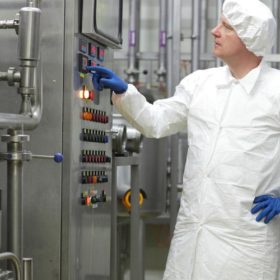
Food Industry Overalls are highly durable, breathable, functional and comfortable.
1. Assess the Risk Levels Involved
Every workplace has its different risk levels for different jobs. The higher the risk levels, the stricter the requirements for workwear become. Assess risk by factors like:
- Perishability of ingredients
- The production process
- The production setup
- The type of end consumer
High-risk jobs: These are jobs like handling ready-to-eat, perishable or unpacked food. The typical products include raw meats, ready-to-eat salads, or spreads. To prevent the entry of microorganisms and contamination, maintain the highest levels of hygiene at all times.
Low-risk jobs: These are the inverse of the above. Handling foods that are not perishable, such as crisps and coffee, fall into this category. Workwear provides simple coverage since packaging provides the required protection for the food.
2. Be Aware of Uniform Requirements in the Food Industry
When it comes to safety regulations, it is always better to be safe than sorry. Are you aware of the basic protective coverings for the food industry? Do you know when to provide them? Brush up on the requirements before you start sourcing uniforms for your staff members.
Head Covering

Proper Head Wear is essential in preventing contamination when working with food.
Hair is a source for both physical and microbial contamination matter. It is imperative that head covering becomes a part of your essential uniform tool kit. Communicate the importance of the head covering to staff members through regular training.
- Hairnets: A basic item for head covering is a hair net. Regardless of the type of hat you choose, ensure all your staff wear a hairnet underneath. This is especially important for people with long hair.
- Hats: To ensure comfort and adequate coverage, choose hats with a generous size that fits hair. Check that the elastic in the net doesn’t cause irritation while staff are working.
- Hard hats – They become a necessity when an impact to the head is a possibility. Buy them if your company has processes that involve an overhead conveyor or cranes. Hard hats are durable and easy to clean.
- Disposable paper hats – They are perfect for catering outlets and assignments. Non-woven disposable hats can be effective for high-risk areas where daily cleaning is critical. This is because they can be cheaper compared to daily laundering.
- Facial hair covering– To cut contamination, cover all head hair, including beards and moustaches. Everyone in the factory should wear beard snoods in disposable fabrics. This also includes visitors, site engineers and contract employees.
Choosing headwear doesn’t have to become complicated. A call to Alsco NZ is all you need. We will give you an account manager who can advise and sort your needs.
Overalls
There are three types of overalls used in food industry workwear. They include a coverall (boiler suit), separate jacket or shirt and trousers, or a coat sometimes paired with trousers.
For ease in usability and versatility, the coat wins. It can be worn over trousers or any clothing that your staff might wear. It works best for jobs with medium to low risk with a diverse workforce.
Footwear
The footwear used in the production area should never leave the production area. Ensure that the shoes are comfortable and well-fitting. The material should also be easy to clean and stored on the storage racks.
Dedicate the footwear to the work area. Wellington boots are perfect for wet processing or cleaning. Colour code the footwear as a reminder of the hygiene requirements of the production area.
Gloves
It is better to have clean hands than dirty gloves. This phrase should be your guiding light when considering how to buy and care for gloves. It’s not easy to realise when a glove gets too dirty. It is important to put in place processes that remove soiled gloves before they outlive their usefulness.
Use gloves when handling the below categories of products:
- High-risk products (e.g., cooked meats) – Natural rubber gloves are the best in terms of usability and safety.
- Sensitive products (e.g., chocolate items) – Thin cotton gloves are good but need to be changed for clean ones at regular intervals.
- Aggressive products (e.g., salt, fish or cartons) – PVC or rubber gloves are best for protection against abrasives or irritants.
- Hot and cold products – Special fabric gloves work well for handling hot items from ovens. Insulated gloves are available for staff working with frozen foods.
3. Be Mindful of Design Needs
The food industry is highly regulated, and New Zealand is no exception. Get acquainted with the laws and regulations that govern food industry uniforms to keep your company safe from litigation.
In a nutshell, these are the general design requirements you should pay attention to:
Use Light or White Fabric
White or other light-coloured uniforms make it easy to inspect for cleanliness. Workwear has to live up to food safety standards.
Use Long-Sleeved Workwear
Food industry workwear in all risk levels must have adjustable long-sleeves. The sleeves are important to protect the food from staff contamination. Always close coats and jackets and ensure they are long enough to cover the side pockets on trousers.
Permanently Attach Your Logos and Emblems
Avoid using logo stickers or tags. Embed the logos directly onto the garment. The transferable sticky logos can loosen with time. Logos need to be of a high enough quality to last the whole life cycle of the workwear to which they are attached.
Use Fitted Garments to Prevent Spills
Fitted uniforms are comfortable and increase staff productivity. A good workwear rental supplier will measure your staff and make sure uniforms fit. Ensure your supplier can do this for you. Providing your own uniforms will prove to be tedious and time-consuming. Get a trusted partner like Alsco NZ to take care of this process for you.
How to Find the Best Food Industry Uniform Vendor
1. Do They Pay Attention to Fabric & Fit?
Do you understand the standard material used for protective clothing? Most protective clothing is now made from a blend of 65% polyester and 35% cotton. These are comfortable to wear, last a long time and absorb spillages.
An adequate supply of clean garments is essential. Everyone should have at least a weekly change in garments, while some will need a daily change. Rent or buy garments on-site or send them to a specialist laundry.
2. What Is the Maintenance and Laundering Process?

Alsco provides a comprehensive Managed Uniform Rental Service to help your business thrive.
Make sure your supplier is right for your business. The food industry CCPs that your supplier needs to be mindful of include:
- Garment material: Traditional apron materials, like vinyl and polyurethane, have cleanability problems. Choosing good materials promotes food and employee safety.
- Carts/plastic tubs: Clean clothes should be transported by designated carts that only carry clean clothes. Line the carts with a disposable plastic liner to ensure clean clothes do not touch carts or soiled garments.
- Pest control: Each laundry-processing plant should minimise hazards through an effective pest control program.
- Gloves: Change disposable gloves worn during the sorting of dirty garments and by handlers of clean laundry before being poly-wrapped.
- Cross-contamination on the service route: Design the process for serving food accounts to prevent cross-contamination.
- Training: Certify all vendor employees on basic food safety and preventing cross-contamination.
- Service trucks: Keep these free of dust and dirt. Separate soiled and cleaned garments on trucks to prevent cross-contamination.
Choosing and maintaining staff uniforms can become an extreme sport if you choose the wrong supplier. When you put these notes into consideration, you will pick a great supplier for you.
A neat trick to get you started is to look out for companies with great recommendations and track records.
The rental workwear service from Alsco NZ is affordable, reliable and always up to par with legal requirements. Don’t take our word for it: Check out what our clients say about us.
Photo: Emiliano García-Page Sánchez
3 Little Details That Set Amazing Restaurants Apart from the Average Ones
Variety is the spice of life, and this is especially true when it comes to dining.
The restaurant industry is one of the most competitive industries in the world. According to a Report by Stats NZ, New Zealanders are spending more time and money dining out than ever before.
Consumers today expect perfect food, service and comfort.
They are on the constant lookout for the next best restaurant. And there’s no reason why your restaurant can’t be one of them.
Consider the Trifecta: Concept, Chef and Location
Your restaurant is like a blank canvas. Every colour on your palette will help shade your diners’ experience from their first bite to the last.
A restaurant will never succeed without these three elements:
A Good Concept
A great restaurant starts with a well-developed concept. Begin by researching the market for eating trends, design styles and consumer spending habits to conceptualise a profile that appeals to your target audience.
To create a fusion of comfort and complete the experience for your guests, you will require:
- Ambience
- Music
- Lighting
- Table linen
- Decor
A restaurant’s ambience is the most important factor to consider when settling for a concept.
Pretend your business is a stage where the limelight focuses on the food as the guests become the spectators.
The music you play helps create ambience depending on your goals and objectives. If your restaurant is a fine dining establishment, you might consider playing low tempo, relaxing music to keep your guests in their seats. This could encourage them to eat and spend more.
You can play fast-paced music in the daytime for faster turnover and mellow music at night for leisurely dining.
Like music, lighting is also a key element to the ambience.
According to John R. Walker, “With the wrong lighting, a restaurant’s entire design will suffer; with the right lighting, the entire restaurant design could flourish.”
Lighting can also directly affect the pace at which people eat. Pairing high tempo music with bright lighting can be used subliminally to get customers in and out faster during high-peak hours of the day.
Dim, warm mood-lighting can be paired with low tempo music in a fine dining restaurant to make the guests feel more relaxed.
Aesthetically pleasing table linen is a must-have for any restaurant today. As consumers continue to post more and more food-related content on social media, they expect to have an aesthetically pleasing, picture-perfect backdrop for their Instagram and Tumblr food photography.
Having clean linens is vital to the success of any restaurant. Make your restaurant stand out from the competition.
- Do this by matching aesthetics that the consumers expect by investing in a linen rental service that delivers a variety of affordable, fresh and high-quality table linen.
The decor is the final element that marries the lighting, music, and tableware to create the desired ambience. Switch up the decor in your restaurant to stay current with the latest interior design trends from time to time.
Doing so will help give your restaurant a fresh new look just by changing up a few elements in the decor. Check out: How to come up with a great restaurant floor plan.
A Great Chef
To begin with, choose your chef carefully. Think about what your food concept is to be able to match your chef’s capabilities to your needs.
The chef is the most significant member of a restaurant’s team. According to a 2018 New Zealand Hospitality Report, “The biggest challenge for hospitality business owners is the lack of skilled employees.”
Therefore, make sure to hire a chef that is well-trained and has years of experience. A great chef should have an eye for detail. Only then will you be sure that every meal they serve tells a story.
The chef is the person who sets standards in a restaurant, and therefore, they should prioritise quality.
The Perfect Location
One thing you’ll have to pay extra attention to is selecting a good location for your restaurant.
Spend time to figure out the location and analyse whether the traffic flow is in line with what you are trying to serve.
It would be ideal to pick an easily accessible location that draws crowds and has the potential for growth.
The most important factor to consider when picking a site is the congruency of the community around whatever concept you want to introduce. Choose a community that you will enjoy serving to be able to build up a loyal customer base.
Select a Location that has high visibility and good foot traffic.
To determine whether a location has good foot traffic, you’ll need to:
- Visit the closest restaurant near the site you wish to set up.
- Survey the number of people walking through the door to have a clear sense of what their daily performance is like, the peak/rush hours, etc.
This will give you an idea of how much revenue they are making and whether the location is your ideal choice.
The Menu Is the Centre of Your Restaurant’s Universe
The menu is a restaurant’s number one sales tool that can determine whether or not your business becomes successful.
It includes a description of how the food is prepared and presents the dishes in an alternative and fun way. Having secured the trifecta (concept, chef and location), many restaurateurs often end up neglecting the menu.
Offer a menu that will be a feast for the eyes and pallet.
Use Descriptive Language to Make Each Dish Offered Sound as Delicious as Possible.
Get into as much detail as you can. This provides more information and can even open up the guest’s appetite depending on how well you’ve managed to describe the dish.
Incorporate words such as:
- Braised
- Seared
- Pan-fried
- Oven-roasted
When used properly on the menu, such words can add a topping of prestige to what you’re serving. You can also highlight special ingredients and point out where they came from.
Try Some Menu Engineering Techniques
There is an art to designing the menu to where the guest’s eyes go and how you want to align it. It is a handy way of influencing customers to purchase certain items on the menu.
Highlighting specific sections of the menu and using enough white space, boxes and borders draws the eye and captures attention.
Try this nifty trick: Put a menu board with pictures of the food outside your restaurant during peak hours. This is an effective way of capturing people’s attention.
Keep track of the latest food trends and try adding new dishes to the menu. This is a great way to stand out! Don’t be afraid to expand your menu to meet your customers’ dietary needs.
Have a Strong Social Media Presence
Social media is a fantastic sales and brand awareness tool for your restaurant. Brand your restaurant on social media platforms like Facebook, Instagram and Twitter in such a way that your content stands out and gets noticed.
The rise of social media has created a new breed of consumers.
According to Facebook’s 2019 Restaurant Trends and Insights Report, 86% of millennials try a new restaurant after seeing food-related content online.
To have an effective online presence, you need to:
- Plan and create strategies and goals. Is it brand awareness or sales? Having a plan will help you make that commitment right from the beginning. The right tools will help you enact that plan.
- Share content that is authentic and engaging. This will help you connect with your audience. For example, taking professional photos of your meals and posting on Facebook, Instagram or Twitter with a creative caption will catch their attention and convince them to give your restaurant a try.
- Collaborate with social media influencers. Living in the era of the influencer means that your restaurant is more likely to succeed if it’s endorsed by a social media influencer or celebrity.
Additionally, you can also have your menu online so guests can gauge various food items and the price range. This makes it much easier for them while ordering because they already have an idea of what they are going to have.
An Easier Alternative
One of the simplest ways of creating an experience full of discovery for the guests, while giving your restaurant a “face-lift” without breaking the bank is by changing the linen frequently.
However, buying new restaurant linen is expensive and impractical to maintain. Alsco NZ has you covered. They offer an affordable and efficient linen rental service with an array of different fabrics, colours and styles to choose from to suit your needs.
You can also indulge your guests in a luxurious, five-star royalty treatment by subscribing to.
They have a wide range of luxurious, high thread-count linen form tablecloths, customisable overlays and serviettes in various sizes and colours to match the standard of your restaurant and pamper your customers.
Their managed rental service means that your soiled linens will be regularly replaced by clean, crisp ones.
Photo: JCOMP


